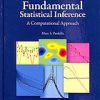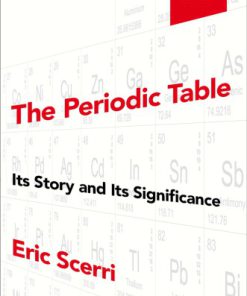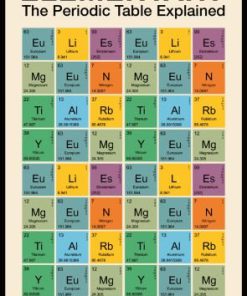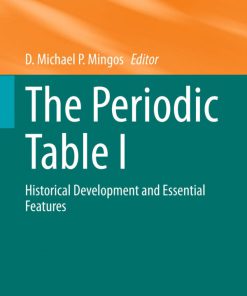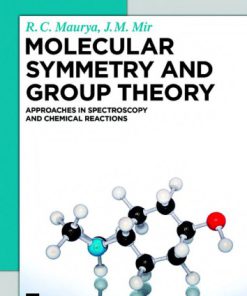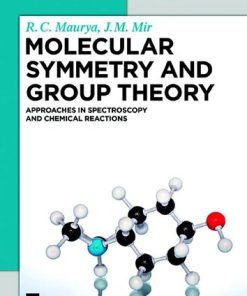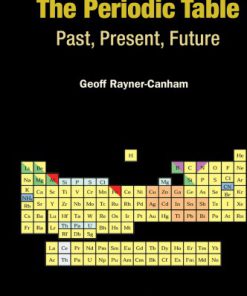Shattered Symmetry Group Theory From the Eightfold Way to the Periodic Table 1st Edition by Pieter Thyssen, Arnout Ceulemans 0190620172 9780190620172
$50.00 Original price was: $50.00.$25.00Current price is: $25.00.
Shattered Symmetry Group Theory From the Eightfold Way to the Periodic Table 1st Edition by Pieter Thyssen, Arnout Ceulemans – Ebook PDF Instant Download/DeliveryISBN: 0190620172, 9780190620172
Full download Shattered Symmetry Group Theory From the Eightfold Way to the Periodic Table 1st Edition after payment.

Product details:
ISBN-10 : 0190620172
ISBN-13 : 9780190620172
Author: Pieter Thyssen, Arnout Ceulemans
Symmetry is at the heart of our understanding of matter. This book tells the fascinating story of the constituents of matter from a common symmetry perspective. The standard model of elementary particles and the periodic table of chemical elements have the common goal to bring order in the bewildering chaos of the constituents of matter. Their success relies on the presence of fundamental symmetries in their core. The purpose of Shattered Symmetry is to share the admiration for the power and the beauty of these symmetries. The reader is taken on a journey from the basic geometric symmetry group of a circle to the sublime dynamic symmetries that govern the motions of the particles. Along the way the theory of symmetry groups is gradually introduced with special emphasis on its use as a classification tool and its graphical representations. This is applied to the unitary symmetry of the eightfold way of quarks, and to the four-dimensional symmetry of the hydrogen atom. The final challenge is to open up the structure of Mendeleev’s table which goes beyond the symmetry of the hydrogen atom. Breaking this symmetry to accommodate the multi-electron atoms requires us to leave the common ground of linear algebras and explore the potential of non-linearity.
Shattered Symmetry Group Theory From the Eightfold Way to the Periodic Table 1st Table of contents:
Part One Space Symmetries
1. A primer on symmetry
1.1 The tragic life of Evariste Galois
1.1.1 Entrance exams
1.1.2 Publish or perish
1.1.3 Galois mathematical testament
1.2 The concept of symmetry
1.2.1 Symmetry defined
1.2.2 The symmetries of a triangle
1.2.3 Quantifying symmetry
1.2.4 Discrete and continuous symmetries
1.2.5 Multiplying symmetries
2. The elements of group theory
2.1 Mathematical definition
2.2 The abstract and the concrete
2.3 Abelian groups
2.4 Examples of groups
2.5 Subgroups
2.6 Symmetry breaking
2.7 Isomorphisms and homomorphisms
2.8 Historical interlude
2.8.1 Evariste Galois
2.8.2 The French school
2.8.3 Sir Arthur Cayley
3. The axial rotation group
3.1 Active versus passive view of symmetry
3.2 Rotation operators
3.3 The axial rotation group
3.4 Transformations of coordinates
3.5 Transformations of coordinate functions
3.6 Matrix representations
3.6.1 Matrix representation of coordinate operators ====MYEQN=i9====
3.6.2 Matrix representation of function operators ====MYEQN=i10====
3.7 The orthogonal group O(2)
3.7.1 Symmetry and invariance
3.7.2 Proper and improper rotation matrices
3.7.3 Orthogonal groups: O(2) and SO(2)
4. The SO(2) group
4.1 Infinite continuous groups
4.1.1 The nature of infinite continuous groups
4.1.2 Parameters of continuous groups
4.1.3 Examples of continuous groups
4.1.4 The composition functions
4.2 Lie groups
4.2.1 Definition
4.2.2 Parameter space
4.2.3 Connectedness and compactness
4.3 The infinitesimal generator
4.3.1 Matrix form of the SO(2) generator
4.3.2 Operator form of the SO(2) generator
4.4 Angular momentum
4.4.1 Classical mechanical picture
4.4.2 Quantum mechanical picture
4.5 SO(2) symmetry and aromatic molecules
4.5.1 The particle on a ring model
4.5.2 The shell perspective
4.5.3 Aromatic molecules
5. The SO(3) group
5.1 The spherical rotation group
5.2 The orthogonal group in three dimensions
5.2.1 Rotation matrices
5.2.2 The orthogonal group O(3)
5.2.3 The special orthogonal group SO(3)
5.3 Rotations and SO(3)
5.3.1 Orthogonality and skew-symmetry
5.3.2 The matrix representing an infinitesimal rotation
5.3.3 The exponential map
5.3.4 The Euler parameterization
5.4 The ====MYEQN=i11==== Lie algebra
5.4.1 The ====MYEQN=i12==== generators
5.4.2 Operator form of the SO(3) generators
5.5 Rotations in quantum mechanics
5.5.1 Angular momentum as the generator of rotations
5.5.2 The rotation operator
5.6 Angular momentum
5.6.1 The angular momentum algebra
5.6.2 Casimir invariants
5.6.3 The eigenvalue problem
5.6.4 Dirac’s ladder operator method
5.7 Application: Particle on a sphere
5.7.1 Spherical components of the Hamiltonian
5.7.2 The flooded planet model and Buckminsterfullerene
5.8 Epilogue
6. Scholium I
6.1 Symmetry in quantum mechanics
6.1.1 State vector transformations
6.1.2 Unitarity of symmetry operators
6.1.3 Transformation of observables
6.1.4 Symmetry transformations of the Hamiltonian
6.1.5 Symmetry group of the Hamiltonian
6.1.6 Symmetry and degeneracy
6.2 Lie groups and Lie algebras
6.2.1 Lie generators
6.2.2 Lie algebras
6.2.3 Hermiticity and Lie generators
6.3 Symmetry and conservation laws
6.3.1 Noether’s theorem
6.3.2 Conserved quantities in quantum mechanics
6.4 The Cartan-Weyl method
6.4.1 The threefold path toward a Cartan-Weyl basis
6.4.2 Review of the angular momentum algebra
6.5 The three pillars of group theory
Part Two Dynamic Symmetries
7. The SU(3) group
7.1 Historical prelude: The particle zoo
7.1.1 Probing the inner structure of the atom (1897–1947)
7.1.2 Yukawa’s pion (1947–1949)
7.1.3 The growing particle jungle (1950–1960)
7.1.4 Quantum numbers and conservation laws
7.1.5 Strangeness (1953)
7.1.6 The Mendeleev of elementary particle physics
7.2 The one-dimensional harmonic oscillator
7.2.1 Classical mechanical treatment
7.2.2 Quantum mechanical treatment
7.3 The three-dimensional harmonic oscillator
7.4 The unitary groups U(3) and SU(3)
7.4.1 The unitary group U(3)
7.4.2 Subgroups of the unitary group U(3)
7.4.3 The generators of U(3)
7.4.4 The generators of SU(3)
7.4.5 The ====MYEQN=i13====(3) Lie algebra
7.4.6 The Cartan subalgebra of ====MYEQN=i14====(3)
7.4.7 The ====MYEQN=i15====, ====MYEQN=i16====, and ====MYEQN=i17==== subalgebras of ====MYEQN=i18====(3)
7.5 The eightfold way (1961)
7.5.1 An octet of particles
7.5.2 Different SU(3) representations
7.5.3 Broken symmetries
7.5.4 In Mendeleev’s footsteps
7.6 Three quarks for Muster Mark (1964)
7.6.1 Aces and Quarks
7.6.2 Mesons
7.6.3 Baryons
7.6.4 Symmetry from the quark perspective
8. SU(2) and electron spin
8.1 From SU(3) to SU(2)
8.2 Spinors and half-integer angular momentum
8.3 The relationship between SU(2) and SO(3)
8.4 The spinning electron
9. The SO(4) group
9.1 The hydrogen atom
9.1.1 A quartet of quantum numbers
9.1.2 “Accidental” degeneracies and the Fock (emphn) rule
9.2 Dynamical symmetries
9.3 Classical Kepler problem
9.3.1 General formulation
9.3.2 Hamiltonian formulation
9.3.3 Constants of the motion
9.3.4 The Laplace-Runge-Lenz vector
9.3.5 Equations of motion
9.3.6 History of the Kepler problem
9.3.7 History of the LRL vector (I)
9.4 Quantum mechanics of the hydrogen atom
9.4.1 Operators for conserved quantities
9.4.2 Conservation laws
9.5 The special orthogonal group SO(4)
9.5.1 The generators of SO(4)
9.5.2 The ====MYEQN=i19====(4) Lie algebra
9.5.3 The Cartan subalgebra of ====MYEQN=i20====
9.6 The origin of accidental degeneracies
9.6.1 Energy levels of the hydrogen atom
9.6.2 History of the LRL vector (II)
9.6.3 Hodographs in momentum space
9.6.4 Stereographic projections in hyperspace
9.6.5 Peeking at the fourth dimension
10 Scholium II
10.1 Oscillator roots of the hydrogen problem
10.1.1 Dimensional considerations
10.1.2 The SU(4) oscillator
10.1.3 The Kustaanheimo-Stiefel transformation
10.2 The transformation of the hydrogen Hamiltonian
10.3 Shattering SU(4) symmetry
Part Three Spectrum-Generating Symmetries
11. The SO(2,1) group
11.1 The road to noninvariance groups
11.1.1 Historical prelude
11.1.2 Invariance groups
11.1.3 Noninvariance groups
11.2 The pseudo-orthogonal group SO(2,1)
11.2.1 From SO(3) to SO(2,1)
11.2.2 The ====MYEQN=i21====(2,tmspace +thinmuskip.1667em 1) Lie algebra
11.2.3 The Cartan-Weyl basis of ====MYEQN=i22====(2,tmspace +thinmuskip.1667em 1)
11.2.4 SO(3) revisited
11.3 Hydrogenic realization of the SO(2,1) group
11.3.1 The radial Schr”odinger equation
11.3.2 The spectrum-generating ====MYEQN=i23====(2,1) algebra
11.4 Dynamical treatment of the radial wave equation
11.5 Dirac’s harmonic oscillator revisited
12. The SO(4,2) group
12.1 The pseudo-orthogonal group SO(4,2)
12.1.1 From SO(6) to SO(4,2)
12.1.2 Hydrogenic realization of the ====MYEQN=i24====(4,2) Lie algebra
12.2 The Cartan-Weyl basis
12.2.1 Cartan subalgebra and Cartan generators
12.2.2 Casimir invariants
12.2.3 Weyl generators
12.2.4 SO(4,2) root diagram
12.2.5 SO(4,2) weight diagrams
12.3 Quantum alchemy
12.3.1 Raising and lowering ====MYEQN=i25====
12.3.2 Raising and lowering
12.3.3 Raising and lowering ====MYEQN=i26====
13. The periodic table
13.1 Chemical periodicity
13.2 Quantum mechanics of atomic systems
13.2.1 One-electron systems
13.2.2 Many-electron systems
13.3 Quantum mechanics of the periodic system
13.3.1 The Fock ====MYEQN=i27==== rule
13.3.2 The hydrogenic ====MYEQN=i28==== rule
13.3.3 The Madelung ====MYEQN=i29==== rule
13.4 The Madelung ====MYEQN=i30==== rule
13.4.1 The left-step periodic table
13.4.2 Period doubling
13.4.3 textitAb initio derivation of the ====MYEQN=i31==== rule
13.5 Misapplying the Madelung rule
13.5.1 The ====MYEQN=i32==== blunder
13.5.2 The concept of an element
13.5.3 Two interpretations of the ====MYEQN=i33==== rule
13.6 Group theory and the periodic system
13.6.1 APA versus EPA
13.6.2 Group theoretical classification of the elements
13.6.3 System and system states
13.6.4 Symmetry and symmetry breaking
13.6.5 Mass formulas
13.7 Literature study
13.7.1 Historical prelude
13.7.2 Demkov and Ostrovsky (St. Petersburg, Russia)
13.8 Conclusion
14. SO(4,2) and the rules of atomic chess
14.1 From the eightfold way to the periodic table
14.1.1 The atomic chessboard
14.1.2 Correlation diagram
14.2 The rules of atomic chess
14.2.1 The king and queen
14.2.2 The rook
14.2.3 The knight
14.2.4 The bishop
14.3 The origin of period doubling
14.4 The quest for the chiral bishop
14.4.1 The Madelung sequences
14.4.2 The Regge sequences
14.5 The algebra of chiral bishops
14.5.1 Standard embedding of SO(3,1) in SO(3,2)
14.5.2 The ====MYEQN=i34==== operator
14.5.3 Construction of Regge and Madelung operators
14.5.4 Regge–like algebras
14.5.5 Madelung–like algebras
14.5.6 Casimir operators
14.6 Nonlinear Lie algebras
14.7 Conclusion
People also search for Shattered Symmetry Group Theory From the Eightfold Way to the Periodic Table 1st:
shattered symmetry
a symmetry shape
a symmetry
the symmetry theory
broken symmetry physics
Tags: Shattered Symmetry, the Eightfold Way, Periodic Table, Pieter Thyssen, Arnout Ceulemans
You may also like…
Chemistry - Chemistry - General & Miscellaneous
The Periodic Table – Its Story And Its Significance 2th Edition Scerri Eric 0190914386 9780190914387
Biology and other natural sciences
Chemistry - Chemistry - General & Miscellaneous
Chemistry - Chemistry - General & Miscellaneous
Chemistry - Chemistry - General & Miscellaneous
The Periodic Table Past Present And Future World Scientific 2020 Geoff Rayner-Canham



